The biggest land rush in the history of the internet begins on February 4
This item has been corrected.

This item has been corrected.
The web is about to have its big bang. About 1,000 new generic top-level domain names, or gTLDs (the last bit of an internet address, such as the com in qz.com) will come into existence this year. On Feb. 4, anybody will be able to create and start running a website on the first of the new domains. The number of alphabets in which you can create a web address will be at least a dozen including Chinese and Arabic. Hundreds of millions of dollars will be made. And our conception of the web will change entirely.
You may not have heard about this. That’s unsurprising. The infrastructure of the internet is rarely a sexy subject, except when it breaks spectacularly. New standards are constantly being adopted in the background. Who can keep track?
The coming deluge of new domains is different. It is highly visible, and will affect everybody who uses the web. What’s less certain is whether it is strictly necessary. Proponents argue that it will benefit people and businesses (small ones especially) by giving them more addresses to choose from. Critics call it a massive land grab by both entrepreneurs and some of the world’s most powerful internet companies.
First, a little background
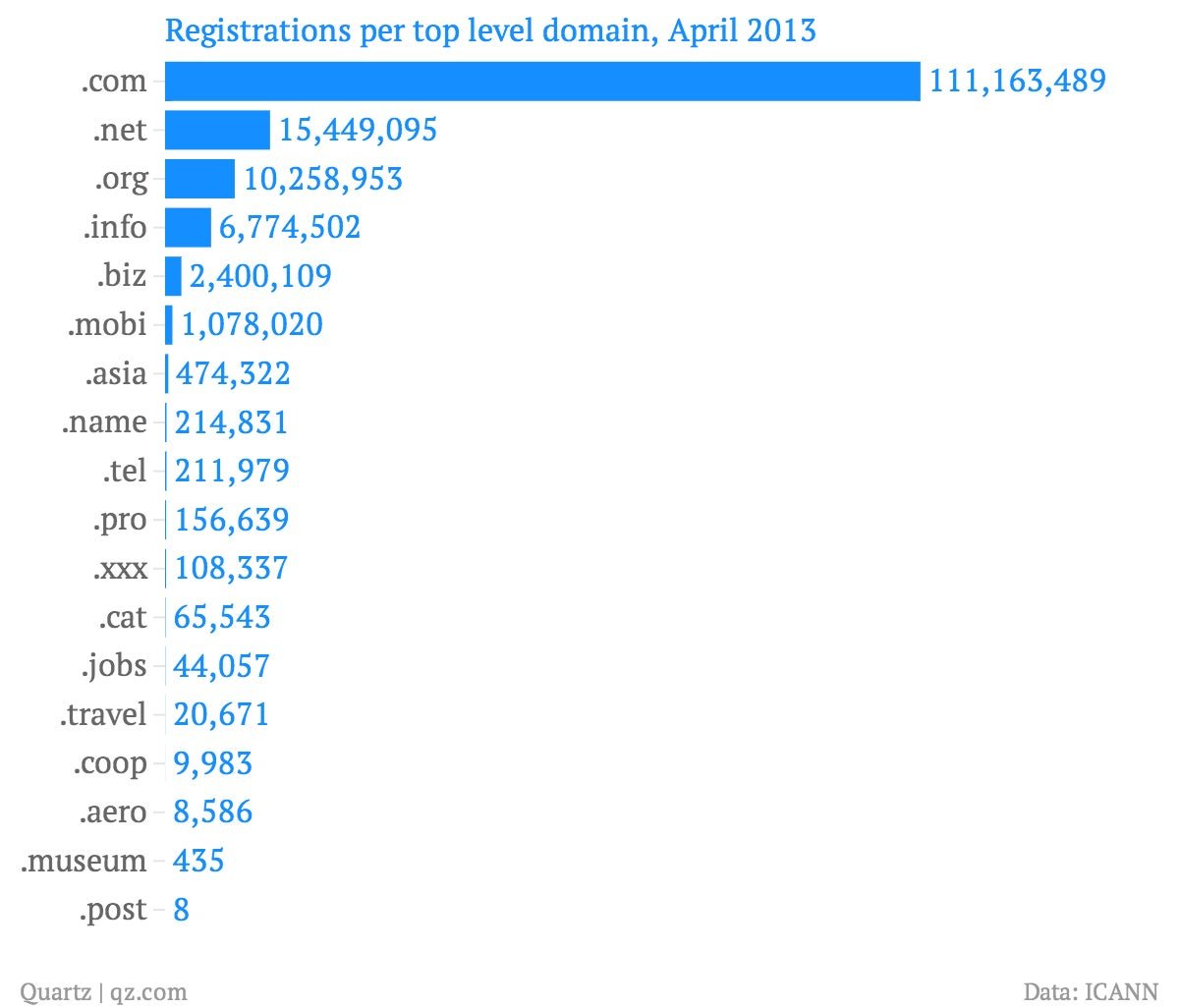
Domain names, the basis of web addresses, are overseen by the Internet Corporation for Assigned Names and Numbers (ICANN). They follow a hierarchy, much like physical addresses. If the web were a country, then a generic top-level domain like .com might be the state or province, and a second-level domain, like google.com, would be a city. Neighborhoods within the city can be found in either a suffix (google.com/images) or a prefix (images.google.com).
Until 2013, there were only 22 functioning gTLDs. The most familiar predated the creation of ICANN: .com, .net, .org, .edu, .gov, and .mil. Another seven came into existence in 2000, and a further eight in 2004. Most of the new domains in these two waves never really took off. You will sometimes spot .biz or .info in the wild, but more niche ones such as .mobi (aimed at mobile sites) and .xxx (for porn) got little attention from the markets they were aimed at.
In addition, countries get their own top-level domains, called ccTLDs. Familiar examples include .de (Germany), .ca (Canada) or .co (Colombia, now used mostly for other purposes). These form another huge chunk of the internet.
The overflowing web
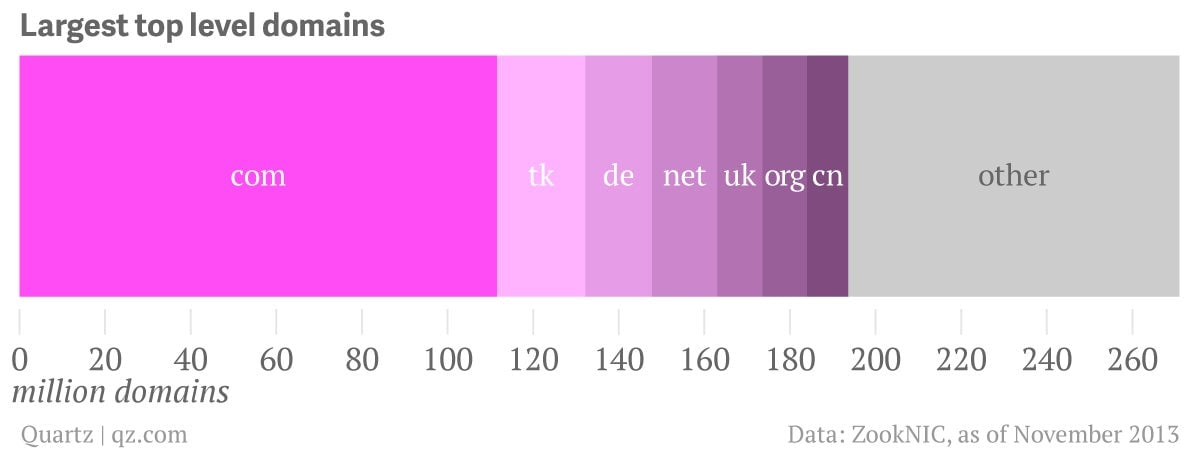
So why create a whole new bunch of gTLDs if .jobs, .travel and the like got so little traction? The argument is that the internet—or .com at least—is running out of space. So many names on .com are taken that people and businesses have to struggle to find a suitable one. ”We’ve gone from an average of four or five letters in a second-level domain to something in excess of 14 to find what you’re looking for,” ICANN’s Cyrus Namazi told Quartz. (This fascinating blog post from March 2012 delves deep into average length and other attributes of domain names.)
Hundreds of new gTLDs means hundreds of times as many available second-level domains. It could even mean an end to the increasingly silly names new businesses have to adopt just so they can secure a memorable web address. Shpoonkle, anyone?
So in June 2008, more than two years after an internal policy group first started considering it, ICANN’s board approved recommendations to create a fourth set of new gTLDs. Rather than planning extensive consultations about what they should be, this time ICANN allowed the market to decide. Anybody could apply to run a new domain, so long as they met certain requirements and coughed up a $185,000 application fee.
Start your engines
Many did. Google applied for 101 gTLDs through a subsidiary. Amazon bid for 76 of them. Donuts (“We are nuts about domain names. We are Donuts.”), a firm set up with more than $100 million specifically to make a business of gTLDs, went after 307 new domains.
In June 2012, ICANN announced it had received a total of 1,930 applications for 1,410 unique domains from about 1,000 different entities. Of the 1,930 applications, 751 names are contested by 231 applicants, which in the case of non-trademarked names will be decided by auction.
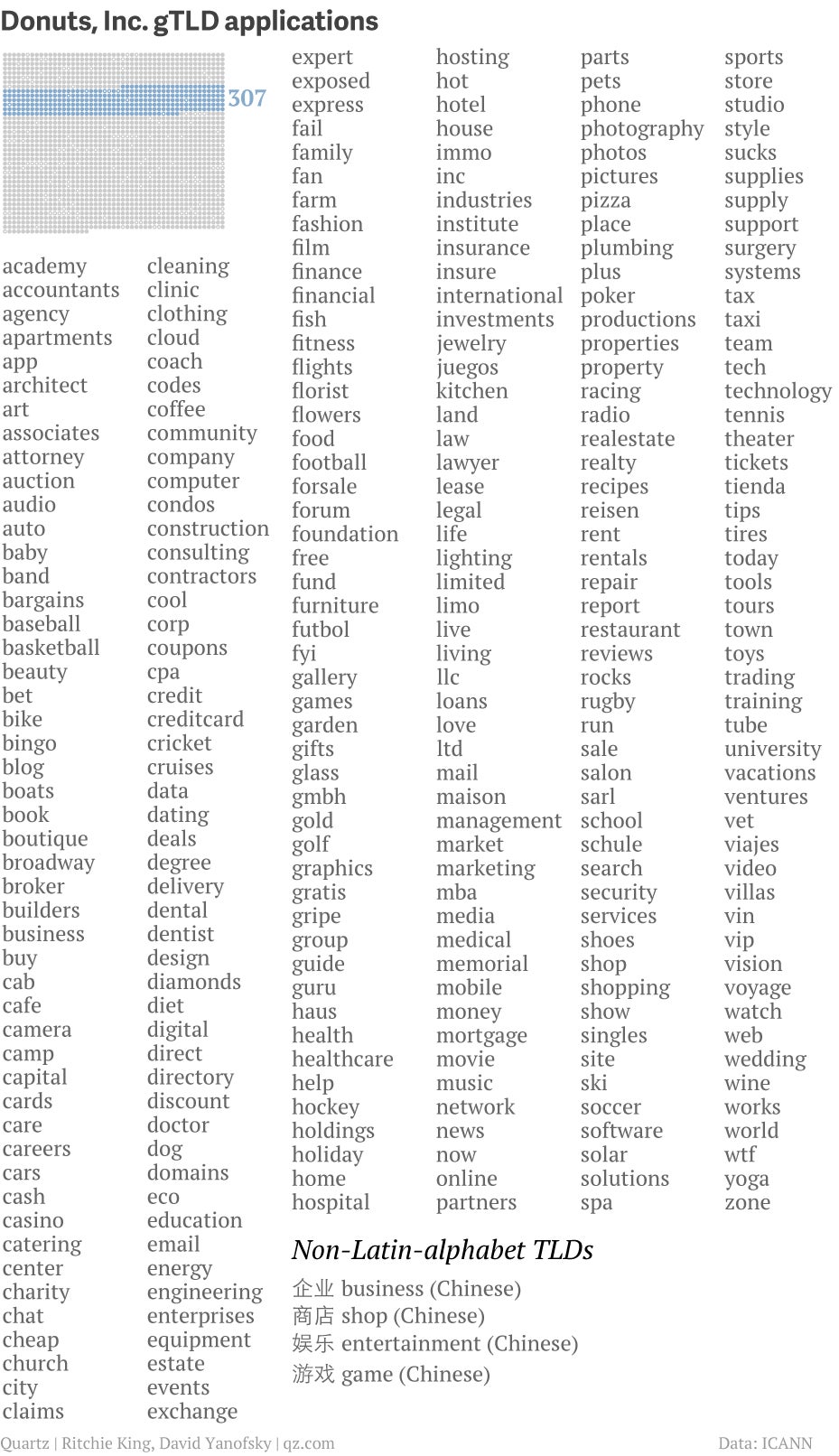
The very first domains to be approved, late last year, were شبكة (Arabic; “web/network”), онлайн (Russian; “online”), сайт (Russian; “site”) and 游戏 (Chinese; “game[s]”), which will allow web addresses to be entirely in those scripts for the first time. These become available for anybody to buy and instantly start running on Feb 4. The first seven new Latin-based top level domains follow the next day. But trademark-holders are already allowed to register, and some sites may start going live in a matter of days.
Roughly 100 applications have already been approved. Namazi told Quartz that the organization is currently approving applications for new gTLDs at a rate of 20 every week. That means there will be 1,000 new ones by the end of this year.
Free money, forever
For its owner, setting up a generic top-level domain is the online equivalent of opening up a vast—in fact, essentially infinite—tract of previously virgin land for development, except that the real estate in question has been conjured out of thin air. In addition to the $185,000 application fee to ICANN, the cost of lawyers, research, traveling to ICANN conferences, and other administrative expenses brings the total cost of an application up to about $1 million, according to one applicant.
But once the initial investment has been recouped, the profits, in theory at least, can be enormous. Whoever wins a top-level domain (say, .news) can sell second-level domains (say, qz.news) on it. Daniel Negari, a 28-year-old American who made his first fortune selling real estate, is planning to make .xyz a generic domain name that anyone can put at the end of any website. Negari thinks he can sell a million second-level domains in his first year of operation, at a price of less than $10 each. (By contrast, .com domains go for $12.99 on GoDaddy, the leading retailer of domain names.) That would be $10 million in revenue in the first year alone.
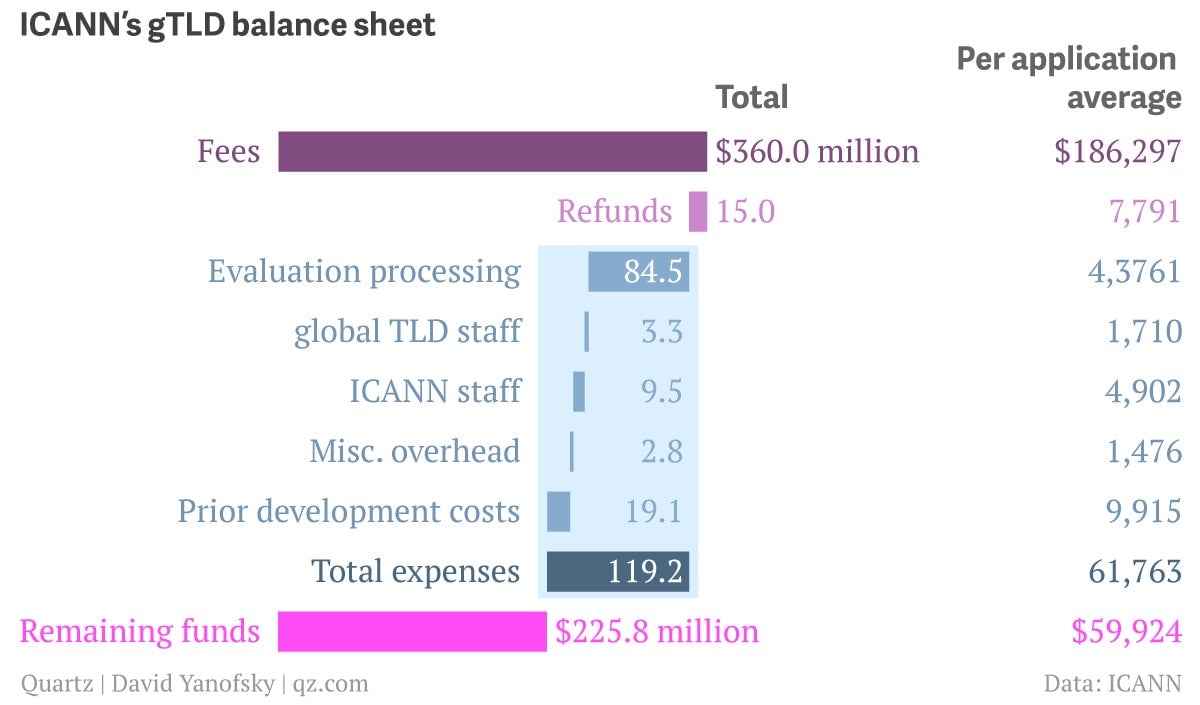
It won’t be pure profit. ICANN takes a cut of 25 cents per second-level domain sold, plus extra fees every quarter and every year. Then there are technical and administrative costs. Still, the applicant for .ninja forecasts margins of around 90% (pdf p.13).
And Negari’s .xyz will be one of the cheaper deals on offer. The .guru TLD is open for pre-registrations (before it officially opens to the general public) on GoDaddy for $39.99 per year. A domain on .ventures is $69.99. One on .luxury starts at $799.99 per year. One of the applicants for .sucks has declared it will ask for $25,000 during the “sunrise period,” a 30-day span during which trademark holders can register their domains to avoid domain-squatting.
…or the web’s biggest white elephant
There is some evidence for the claim that there’s demand for more top-level domains. Nick Nelson of Rightside, which applied for 26 gTLDs, says that research showed 230,000 existing domain names ending with the word “review” or “reviews” (like asiainsurancereview.com or moviereviews.com) and hundreds of thousands, if not millions, ending with “online.” That, he says, is proof of pent-up demand. A survey by another applicant found that 45% of small businesses in the US do not have a website or blog and that half of those who do aren’t satisfied with the ones they have.
Advocates of new gTLDs also point to Juan Diego Calle, who won a contract from the government of Colombia to run its country domain, .co, in 2009. He has made a remarkable success of selling it as a top-level domain for start-ups and as a shorter alternative to .com. Calle says .co has had more than 1.6 million registrations since it went live in 2010, exceeding the ill-fated .mobi.
Yet the story of .co may prove more about the power of marketing than the need for more domains. Danny Sullivan of searchengineland.com, an authority on web marketing, dismisses the notion that having a literal web address directly related to your product helps a brand. The internet’s leading seller of second-level domain names, he points out, is called GoDaddy, not domains.com.
Another much-touted benefit of having more TLDs is that it will make it easier for search engines to find websites. A website called ladygaga.tickets, according to this theory, should rank higher in search results than ladygagatickets.com. However, Matt Cutts, who works on search quality and webspam at Google, has publicly denounced the notion. “I don’t expect a new TLD to get any kind of initial preference over .com,” he wrote in March 2012, ”and I wouldn’t bet on that happening in the long-term either… You shouldn’t register a TLD in the mistaken belief that you’ll get some sort of boost in search engine rankings.”
The case against
Meanwhile, there are also three main arguments against expanding the web’s naming system.
First, people rarely type in full web addresses—even familiar ones like facebook.com—any more, preferring to simply search (pdf, p.224) for a site. This has been especially true since web browsers, following the lead of Google Chrome’s “omnibox,” started combining their search field and address bar into one.
Another argument Namazi says he has heard is the “web is dead” argument, which says that apps and other ways of interacting with the web are gaining prominence. Apps don’t have URLs (i.e., web addresses) and aren’t accessed through web browsers. This obviates the need for more web addresses. (Mind you, there’s also a contrary view that apps are dying out and the web will take over.)
The third argument is that web addresses have become meaningless, not least because of the increasing use of URL shorteners like bit.ly. People will click on any old rubbish without noticing or caring what the actual web address is.
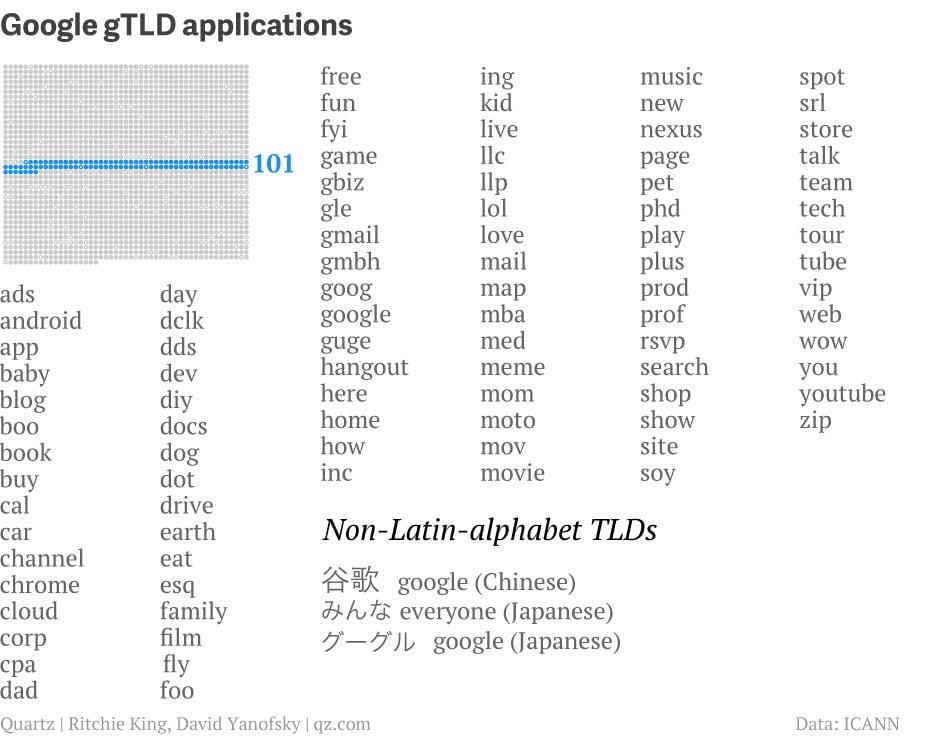
The ghettoized web…
Only a handful of the new domains are truly generic terms like .web, .app (which is the most hotly-contended, with 13 applicants), .website, and Negari’s .xyz. Most are aimed at specific crowds. Non-Latin domains account for 116. Geographic ones (such as .nyc and .london) make up 66. And 485 applications are from brands such as .kpmg, .ram and .bmw. BMW is rumored to be considering assigning a unique web address to every car it sells. (The company wouldn’t comment.)
Most of the requested domains are aimed at small, specific groups. Thus .build is meant for builders, .college for educational institutions, .wedding for couples. Such gTLDs expect to sell between a few thousand and few hundred thousand second-level domains, which goes some way to explaining why their prices are also higher than generic one like Negari’s .xyz. None of the niche names will ever be big on their own, says Mike McLaughlin of GoDaddy, but together they will drive substantial sales.
According to Namazi, this distinct segregation gives “legitimacy and capability to different societies [and] communities on the internet.” Registries will have to vet registrants, he says, which will make the internet safer for users because they will know that the website they’re on is what it claims to be.
Others think it’s a dangerous idea: “I think there is some risk of confusing people. People have been trained to go to their banking websites only if it ends in .com or .co.uk and now if you get them to go to .secure or .bank it could create a false sense of security,” says David Ulevitch of OpenDNS, an internet infrastructure company that helps web users get to the right website. And a system that relies on hundreds of registrars to check the millions of people to whom they sell web addresses is unlikely to be perfect; for instance, Negari says .college will be open even to those who don’t qualify for .edu.
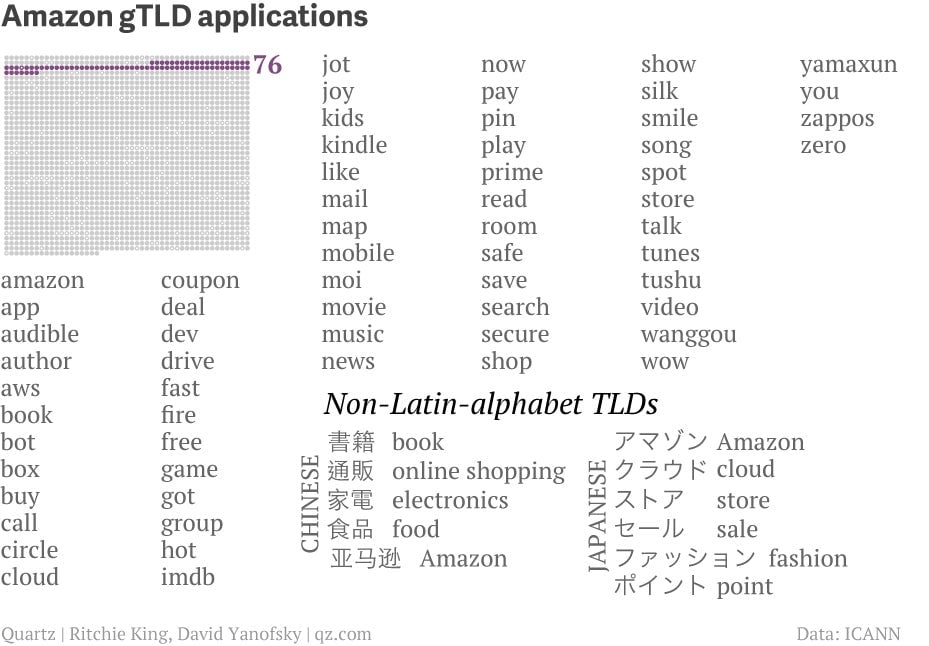
…and the corporatized web
There is something of a landgrab vibe to the whole thing. (Indeed, the time set aside for preferential registration before the gTLDs open to the general public is officially called the “landrush period“.) Promoters say that many applicants for gTLDs are people with little experience in the business of domain names, who invested in just one or two domains that they hope to develop. But in cases where several applicants have claims on a gTLD, the only way to resolve the dispute is through an auction, which smaller competitors will almost certainly lose.
To critics, that means the consolidation of the new web in the hands of the biggest players. Some fear anti-competitive practices. An inter-governmental committee set up to review applications warned that Google and Amazon’s applications for .app propose to “exclude any other entities, including potential competitors, from using the TLD.” (Amazon declined to comment; Google has said (pdf) it will not restrict usage of .app to any particular platform.)
The road to paradise
Real-estate and infrastructure metaphors are to be found everywhere in the world of domains. Namazi describes the changes as a “time for us to now to go from a two-lane highway that took us to this beautiful beachfront property to a multitude of roads that take us there. And our role at ICANN is to build those roads and give access to everyone to be able to use them.”
But it is not a wide-open public beach that Namazi sees at the end the highway; it is beachfront property with a land title. The question is, how will its owners treat the web’s landless multitudes?
Correction (Jan 22): An earlier version of this story misstated the availability of registering domain names in non-Latin scripts. Such domains could be registered since 2010. It also incorrectly equated a domain name with a web address, when it is, rather, part of a web address.